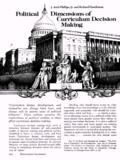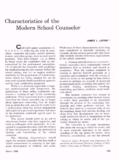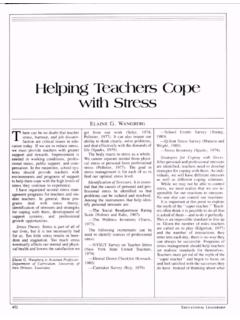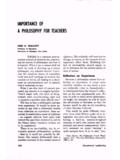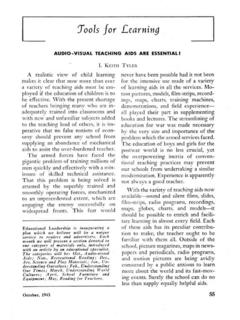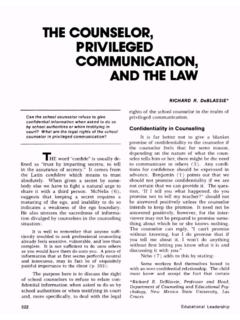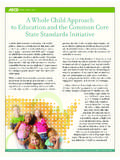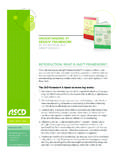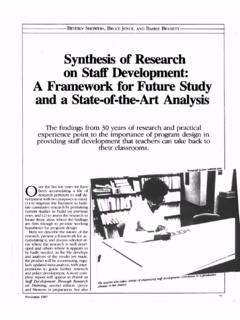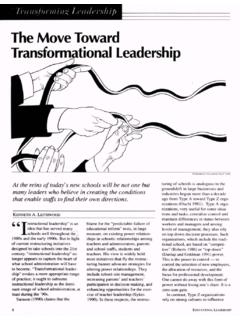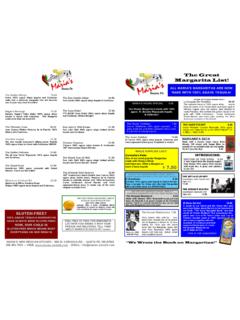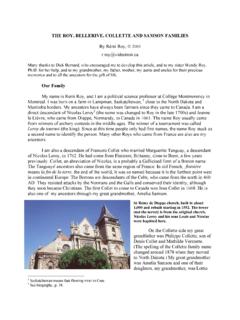Transcription of CURRICULUM DEVELOPMENT SINCE 1900 - ASCD
1 `roof`rirjabsbilmjbkqpfk`b=NVMMRALPH W. TYLERThe locus of responsibility for CURRICULUM DEVELOPMENT has changed considerably in the last 80 years. Prior to 1910, state educa tion authorities prepared and ap proved lists of subjects to be taught in public elementary schools in their states. In some states, this responsi bility was delegated to the education authority of the county, town, or city. At that time, the CURRICULUM was viewed almost solely as the list of subjects and the sequence in which they were to be school subjects were divided into skills and content. It was believed that when students had mas tered the skill subjects (reading, writing, and arithmetic), they had the tools to master the content sub jects (geography and history).Few differences were to be found in the lists of skill subjects prescribed by the various states. There were some differences in content subjects, because states usually required teach ing the history and geography of their state, but otherwise the course of study didn't vary Thorndike reported his ex periments, which clearly contradicted the notion that particular subjects disciplined students' faculties mem ory, imagination, and reasoning and when Dewey wrote about his school in Chicago, where school learning activities were part of the student's efforts to understand and deal with the larger world, educational leaders began to think of the CURRICULUM as more than a list of school maintained that the ele ments learned in school must be identical with those in life outside the school in order for school learn ing to be transferred to the world outside.
2 Dewey emphasized the need for continuity of experiences in school and seminal reports stimulated empirical CURRICULUM studies of such matters as the arithmetic problems children and adults actually encounter in their daily lives, the vocabulary found in materials read by children, the situations in which children and youth have a need or opportunity to write, the reading interests of chil dren, and the ~ =tK=q = =a =b I=` = =^ ~ =p = = =_ J= ~ ~ =p I=` ~ I=f KPhoto: L ~ = f Congrtlsp ~ I= = I=~ = = ~ = = = = = ~ = KAnother series of CURRICULUM studies emerged from the psy chological investigations of reading, writing, and arithmetic. For example, when studies showed that readers did not build up word recog nition from recognizing the letters, but recognized the word as a whole before they perceived the letters, a new reading series was produced based on initial word 1910 to 1930 the published courses of study issued by the states for public elementary schools changed very little except to add nature study as a content subject in the upper grades.
3 But the actual CURRICULUM objectives, content, and learning ex periences changed markedly in those schools that adopted new text books and methods, and helped teachers learn to use dependence on the local school was recognized by several city school administrators as early as 1921. In Denver and St. Louis, citywide CURRICULUM DEVELOPMENT projects were undertaken at the ele mentary level. In both cities, the CURRICULUM was changed to be more in line with children's abilities and interests, and to include activities relevant to life in those cities. These changes could be made in the local CURRICULUM without changing the state-mandated courses of it was found that continuance of the reforms required continued psychological support by the com munity, continuing inservice educa tion, and instructional materials relevant to the new these conditions, the cur- riculums lost much of their dynamic quality.
4 When the administrators who had given leadership to CURRICULUM DEVELOPMENT left Denver and St. Louis, active efforts waned and the new curriculums began to lose some of their reform =p =` The early high school CURRICULUM was determined not so much by state courses of study as by the views _ of college leaders about the subjects essential to preparation for college. A list of subjects prepared by the Com mittee of Ten in 1893 largely domi nated the college preparatory pro gram of American high schools until the 1912, all states had established public high schools and, although at that time less than 10 percent of American youth were graduating from high school, the enrollment of young people not planning to go to college was increasing. These young people and their parents considered the pre vailing high school CURRICULUM unre lated to their goals. With support from farmers, labor groups, and em ployers, the Smith-Hughes Act was passed in 1917, authorizing federal funds for high school vocational pro grams.
5 State boards of vocational edu cation were made responsible for de fining the CURRICULUM for such pro grams, with the result that they were more tightly controlled by the state than most general education courses. The great depression of the 1930s created a sense of crisis in American schools. Students were living in a world that had changed so much they didn't understand what was happen ing or what they could do about it. High school graduates in large num bers were unable to find work and felt their schooling had not prepared them to be independent adults. Many edu cators began reexamining the curricu lum, seeking to make significant re forms. The period from 1931 until 1942, when the United States got deeply involved in World War II, saw extensive CURRICULUM that efforts by city school districts to construct new educational programs had not been followed by similar activity in states where the cities were located, two states, Kansas and Virginia, undertook statewide CURRICULUM DEVELOPMENT projects.
6 These involved reexamination of the entire CURRICULUM , formation of a comprehensive set of scope and se quence guidelines, and experimenta tion with a variety of new kinds of learning the projects in Denver and St. Louis had shown that teachers who participated actively in the plan ning of new programs were generallyMAY 1981 RVVable to use them as planned, while other teachers often were not, the pro cedures used in both Kansas and Vir ginia provided for wide-scale involve ment of teachers. As these projects proceeded, the sheer magnitude of the effort proved far greater than antici pated. Available resources of leader ship and time were inadequate, and eventually the projects were discon tinued. However, they left a residue of ideas and guidelines that influenced teachers and administrators in many schools, not only in these states but in need for new educational pro grams in American high schools be came more obvious as the depression deepened.
7 Unemployment among youth was nearly 100 percent. High school enrollments doubled as young people, finding no jobs, stayed on in school. Generally, there were only two educational programs available: college preparatory and Smith-Hughes vocational. Most of the new students were not planning to enter college and they were not able to enroll in the vocational courses, which were quite selective. High schools were pressured to develop new large efforts were under taken in response. The Eight-Year Study, sponsored by the Commission on Relation of School and College of the Progressive Education Associa tion, was the first and probably best known. Others included the High School Study of the Southern Asso ciation, the High School Study of the Negro High School Association, and the Michigan Study of Secondary Schools. As these projects proceeded it became clear that plans drawn up by central committees or by expert consultants were not being carried out by most teachers.
8 Unless they believed in the programs, understood their roles, had the necessary knowledge and skills, and felt confident they could use the new programs success fully, teachers would not try them. Leaders of the Eight-Year Study established summer workshops and weekend committee activities to pro vide opportunities for teachers to de velop the necessary interest, under standing, skills, and Eight-Year Study also found a need for intellectual resources on which teachers could draw. A Com mission on the Secondary School Cur riculum was established with sub committees in all the major subjectareas. These subcommittees, com posed in each case of persons with special competence in the subject, ex plored possible contributions the sub ject could make to the DEVELOPMENT of young people in the light of current social , an intensive study was undertaken to furnish in formation about the interests, abilities, and needs of American youth and to encourage teachers to learn more about their own students.
9 With these resources in ideas and data, and with opportunities for teach ers to learn and produce resource units that became common property on which all teachers could draw, most of the schools participating in the project developed amazingly com prehensive curriculums.` =a =p With the surprise attack on Pearl Harbor, the focus of CURRICULUM de velopment suddenly shifted. No longer were many youth unemployed. The nation's efforts were concentrated on winning the war and the schools were expected to do their part. This included helping young people under stand the critical situation facing the nation and to support wartime meas ures taken by the government. More directly, schools were expected to provide preinduction training for the students who would be entering the military service, and to provide train ing for the war industries, both for regular students and for young adults.
10 These new expectations resulted in the shelving of other CURRICULUM de velopment activities until after the war was a dozen years after 1946, schools responded to well-intended but naive pressures to change the cur riculum so as to include the content viewed as important by different pres sure groups. These included the one- world emphasis, air-age education, anticommunism courses, global under standing, environmental education, free enterprise units, physical fitness courses, and the like. In some cases, funds were provided to support de velopment of instructional materials, and some programs were funded to educate teachers in these areas. Most schools did not become actively in volved, and none of the efforts seem to have had permanent effect. In those states where special programs were supported by statutory require ments, the mandates were widely ignored. Less obvious may have been changes in the attitudes and under standing of some teachers and in the content of the several school announcement in 1957 that the Soviet Union had produced and launched an artificial satellite aroused public fear that the United States had fallen behind Russia in its collective knowledge and skills.
